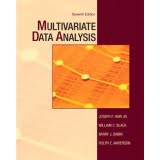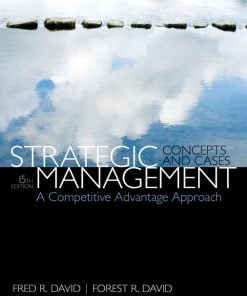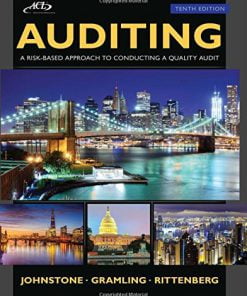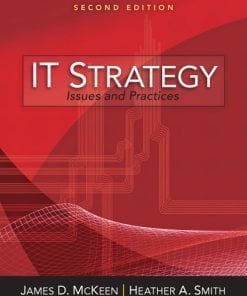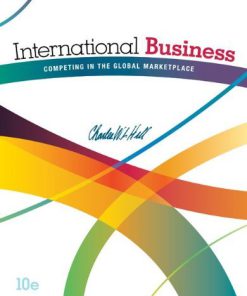Solution Manual for Forecasting And Predictive Analytics With Forecast X, 7Th Edition by Keating
$35.00 Original price was: $35.00.$26.50Current price is: $26.50.
Solution Manual for Forecasting And Predictive Analytics With Forecast X, 7Th Edition by Keating
Instant download Solution Manual for Forecasting And Predictive Analytics With Forecast X, 7Th Edition by Keating pdf docx epub after payment.
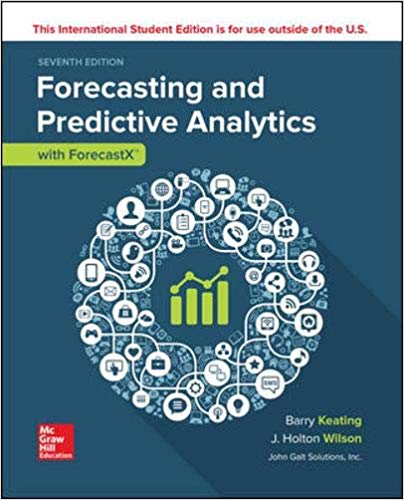
Product details:
- ISBN-10 : 1259903915
- ISBN-13 : 978-1259903915
- Author:J. Holton Wilson
Forecasting and Predictive Analytics, Seventh Edition, is the most practical forecasting book on the market with the most powerful software: ForecastX. This edition presents a broad-based survey of business forecasting methods, including subjective and objective approaches. The authors, Keating and Wilson, deliver practical how-to forecasting techniques, along with dozens of real-world data sets while holding theory and math to a minimum.
Today, most business planning routinely begins with a sales forecast. Whether you are an accountant, a marketer, a human resources manager, a data scientist, or a financial analyst, sooner or later, you will have to predict something. This book is designed to lead students through the most helpful techniques to use in any prediction effort.
Table Of Contents:
- Section 1: Time Series Models
- Section 2: Demand Planning
- Section 3: Analytics
- Quantitative Forecasting Has Become Widely Accepted
- Forecasting in Business Today
- Comments from the Field: Post Foods
- Comments from the Field: Petsafe
- Comments from the Field: Global Forecasting Issues, Ocean Spray Cranberries
- Forecasting in the Public and Not-for-Profit Sectors
- A Police Department
- The Texas Legislative Board
- The California Legislative Analysis Office
- Forecasting and Supply Chain Management
- Collaborative Forecasting
- Computer Use and Quantitative Forecasting
- Qualitative or Subjective Forecasting Methods
- Sales Force Composites
- Surveys of Customers and the General Population
- Jury of Executive Opinion
- The Delphi Method
- Some Advantages and Disadvantages of Subjective Methods
- New-Product Forecasting
- Using Marketing Research to Aid New-Product Forecasting
- The Product Life Cycle Concept Aids in New-Product Forecasting
- Analog Forecasts
- Test Marketing
- Product Clinics
- Type of Product Affects New-Product Forecasting
- The Bass Model for New-Product Forecasting
- Forecasting Sales for New Products That Have Short Product Life Cycles
- A Simple Naive Forecasting Model
- Evaluating Forecasts
- Using Multiple Forecasts
- Sources of Data
- Forecasting Total New Houses Sold
- Steps to Better Time Series Forecasts
- Integrative Case: Forecasting Sales of the Gap
- Background of the Gap and Gap Sales
- An Introduction to ForecastX™
- Forecasting with the ForecastX Wizard™
- Using the Five Main Tabs on the Opening ForecastX™ Screen
- Suggested Readings and Web Sites
- Exercises
- Chapter 2 The Forecast Process, Data Considerations, and Model Selection
- Introduction
- The Forecast Process
- Trend, Seasonal, and Cyclical Data Patterns
- Data Patterns and Model Selection
- A Statistical Review
- Descriptive Statistics
- The Normal Distribution
- The Student’s t-Distribution
- From Sample to Population: Statistical Inference
- Hypothesis Testing
- Correlation
- Correlograms: Another Method of Data Exploration
- Total New Houses Sold: Exploratory Data Analysis and Model Selection
- Business Forecasting: A Process, Not an Application
- Integrative Case: The Gap
- Comments from the Field: Anchorage Economic Development Center Secures Time-Saving Forecasting Accuracy
- Using ForecastXTM to Find Autocorrelation Functions
- Suggested Readings
- Exercises
- Chapter 3 Extrapolation 1. Moving Averages and Exponential Smoothing
- Moving Averages
- Simple Exponential Smoothing
- Holt’s Exponential Smoothing
- Winters’ Exponential Smoothing
- The Seasonal Indices
- Adaptive–Response-Rate Single Exponential Smoothing
- Using Single, Holt’s, or ADRES Smoothing to Forecast a Seasonal Data Series
- New-Product Forecasting (Growth Curve Fitting)
- Gompertz Curve
- Logistics Curve
- Bass Model
- The Bass Model in Action
- Event Modeling
- Forecasting Jewelry Sales with Exponential Smoothing
- Summary
- Integrative Case: The Gap
- Using ForecastXTM to Make Exponential Smoothing Forecasts
- Suggested Readings
- Exercises
- Chapter 4 Extrapolation 2. Introduction to Forecasting with Regression Trend Models
- The Bivariate Regression Model
- Visualization of Data: An Important Step in Regression Analysis
- A Process for Regression Forecasting
- Forecasting with a Simple Linear Trend
- Using a Causal Regression Model to Forecast
- A Jewelry Sales Forecast Based on Disposable Personal Income
- Statistical Evaluation of Regression Models
- Basic Diagnostic Checks for Evaluating Regression Results
- Using the Standard Error of the Estimate
- Serial Correlation
- Heteroscedasticity
- Cross-Sectional Forecasting
- Forecasting Total Houses Sold with Two Bivariate Regression Models
- Comments from the Field
- Integrative Case: The Gap
- Using ForecastXTM to Make Regression Forecasts
- Further Comments on Using ForecastXTM to Develop Regression Models
- Suggested Readings
- Exercises
- Chapter 5 Explanatory Models 1. Forecasting with Multiple Regression Causal Models
- The Multiple-Regression Model
- Initial Considerations When Selecting Independent Variables
- Developing Multiple-Regression Models
- A Three-Dimensional Scattergram
- Statistical Evaluation of Multiple-Regression Models
- The First Four Quick Checks in Evaluating Multiple-Regression Models
- Multicollinearity
- Serial Correlation: An Extended Look
- Serial Correlation and the Omitted-Variable Problem
- Alternative-Variable Selection Criteria
- Accounting for Seasonality in a Multiple-Regression Model
- Using a Dummy Variable to Account for a Recession
- Extensions of the Multiple-Regression Model
- Advice on Using Multiple Regression in Forecasting
- Independent Variable Selection
- The Gap Example (With Leading Indicators)
- Integrative Case: The Gap
- Using ForecastXTM to Make Multiple-Regression Forecasts
- Suggested Readings
- Exercises
- Appendix: Combining Forecasts (Ensemble Models)
- Introduction
- Bias
- What Kinds of Forecasts Can be Combined?
- Considerations in Choosing the Weights for Combined Forecasts
- One Technique for Selecting Weights When Combining Forecasts
- An Application of the Regression Method for Combining Forecasts
- Summarizing the Steps for Combining Forecasts
- Integrative Case: The Gap
- Using ForecastXTM to Combine Forecasts
- Suggested Readings
- Exercises
- Chapter 6 Explanatory Models 2. Time-Series Decomposition
- The Basic Time-Series Decomposition Model
- Deseasonalizing the Data and Finding Seasonal Indices
- Finding the Long-Term Trend
- Measuring the Cyclical Component
- Overview of Business Cycles
- Business Cycle Indicators
- The Cycle Factor for Private Housing Starts
- The Time-Series Decomposition Forecast
- Forecasting Winter Daily Natural Gas Demand at Vermont Gas Systems
- Integrative Case: The Gap
- Using ForecastXTM to Make Time-Series Decomposition Forecasts
- Suggested Readings
- Exercises
- Chapter 7 Explanatory Models 3. ARIMA (Box-Jenkins) Forecasting Models
- Introduction
- The Philosophy of Box-Jenkins
- Moving-Average Models
- Autoregressive Models
- Mixed Autoregressive and Moving-Average Models
- Stationarity
- The Box-Jenkins Identification Process
- ARIMA: A Set of Numerical Examples
- Example 1
- Example 2
- Example 3
- Example 4
- Forecasting Seasonal Time Series
- Total Houses Sold
- ARIMA in Actual Use: Intelligent Transportation Systems
- Integrative Case: Forecasting Sales of the Gap
- Overfitting
- Using ForecastXTM to Make ARIMA (Box-Jenkins) Forecasts
- Suggested Readings
- Exercises
- Appendix: Critical Values of Chi-Square
- Chapter 8 Predictive Analytics: Helping to Make Sense of Big Data
- Applying Analytics in Financial Institutions’ Fight Against Fraud
- Introduction
- Big Data
- Analytics
- Big Data and Its Characteristics
- “Datafication”
- Data Mining
- Database Management
- Data Mining Versus Database Management
- Patterns in Data Mining
- The Tools of Analytics
- Statistical Forecasting and Data Mining
- Terminology in Data Mining: Speak Like a Data Miner
- Correlation
- Early Uses of Analytics
- The “Steps” in a Data Mining Process
- The Data Itself
- Overfitting
- Accuracy and Fit (Again)
- Some Other Data Considerations
- Sampling/Partitioning
- Diagnostics (Evaluating Predictive Performance)
- The Confusion Matrix and Misclassification Rate
- The Lift Chart
- The Receiver Operating Curve (ROC) and Area Under the Curve (AUC)
- What Is to Follow
- Suggested Readings
- Exercises
- Chapter 9 Classification Models: The Most Used Models in Analytics
- Introduction
- A Data Mining Classification Example: k-Nearest-Neighbor (kNN)
- A Business Data Mining Classification Example: k-Nearest-Neighbor (kNN)
- Classification Trees: A Second Classification Technique
- A Business Data Mining Example: Classification Trees
- A Business Data Mining Example: Regression Trees
- Naive Bayes: A Third Classification Technique
- Logit: A Fourth Classification Technique
- Bank Distress
- Summary
- Suggested Readings
- Exercises
- Chapter 10 Ensemble Models and Clustering
- Introduction
- Ensembles
- Error Due to Bias
- Error Due to Variance
- The Case for Boosting and Bagging
- Bagging
- Boosting
- Random Forest®
- A Bagging Example
- A Boosting Example
- A Random Forest (i.e., Tree) Example
- Clustering
- Usefulness of Clustering
- How Clustering Works
- A Clustering Example (k-Means Clustering)
- A Hierarchical Clustering Example (Agglomerative Bottom-Up Clustering)
- Suggested Readings and Web Sites
- Exercises
- Chapter 11 Text Mining
- Introduction
- Why Turn Text into Numbers?
- Where to Start—The “Bag of Words” Analysis
- Newsgroups
- In Pictures
- Understanding SVD
- Back to the Usenet Example
- A Logistics Regression Classification of the Usenet Postings
- Natural Language Processing
- Data Mining and Text Mining Combined
- Target Leakage
- Conclusion
- Suggested Readings
- Exercises
- Chapter 12 Forecast/Analytics Implementation
- Forecasting Involves a Definite Flow
- The Forecast Process
- A Nine-Step Forecasting Process
- Step 1. Specify Objectives
- Step 2. Determine What to Forecast
- Step 3. Identify Time Dimensions
- Step 4. Data Considerations
- Step 5. Model Selection
- Step 6. Model Evaluation
- Step 7. Forecast Preparation
- Step 8. Forecast Presentation
- Step 9. Tracking Results
- Choosing a Forecasting Technique
- Sales Force Composite (SFC)
- Customer Surveys (CS)
- Jury of Executive Opinion (JEO)
- Delphi Method
- Naive
- Moving Averages
- Simple Exponential Smoothing (SES)
- Adaptive–Response-Rate Single Exponential Smoothing (ADRES)
- Holt’s Exponential Smoothing (HES)
- Winters’ Exponential Smoothing (WES)
- Regression-Based Trend Models
- Regression-Based Trend Models with Seasonality
- Regression Models with Causality
- Time-Series Decomposition (TSD)
- ARIMA
- Data Mining
- Text Mining
- Special Forecasting Considerations
- Event Modeling
- Combining Forecasts (Ensembles)
- New-Product Forecasting (NPF)
- Data Mining
- Text Mining
- Using ProcastTM in ForecastXTM to Make Forecasts
- Suggested Readings
- Exercises
- Index
People also search:
forecasting and predictive analytics with forecast x pdf
forecasting and predictive analytics with forecastx 7th edition pdf
forecasting and predictive analytics
Related products
Solution Manual
Solution Manual
Solution Manual
Solution Manual for Absolute C++, 5/E 5th Edition Walter Savitch
Solution Manual
Solution Manual
Auditing A Risk Based-Approach to Conducting a Quality Audit Johnstone 10th Edition Solutions Manual
Solution Manual
International Business Competing in the Global Marketplace Hill 10th Edition Solutions Manual







